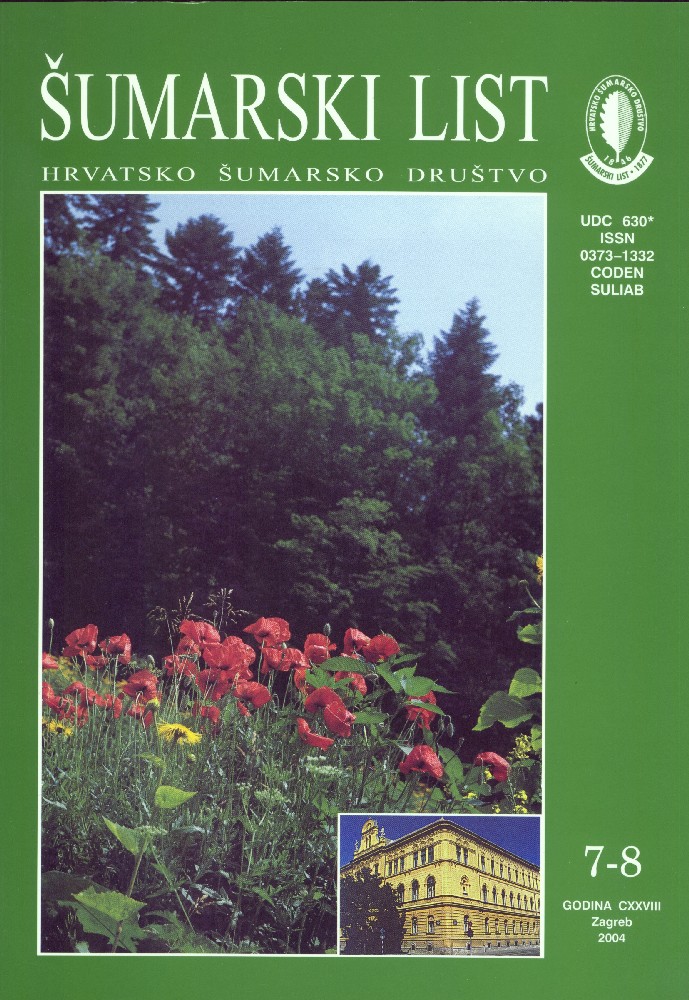
broj: 7-8/2004
pdf (29,5 MB) |
|
||||||||||||||
| IZVORNI ZNANSTVENI ČLANCI | ||
| Pilaš, I., Seletković, A. | UDK 630* 181.3 + 581 | |
| An Analysis of Groundwater Regime of Lowland Našice Forest Area by Use of Grass Gis pdf HR EN | 363 | |
| Trinajstić, I. | UDK 630* 188 | |
| Nomenclatural and Syntaxonomic Revision of the Complex “Blechno-Fagetum (Ht. 1950) Ex Marinček 1970” (Luzulo-Fagion) pdf HR EN | 375 | |
| Zečić, Ž., Poršinsky, T., Šušnjar, M. | UDK 630* 305 + 242 | |
| Some Harvesting Results in Hilly Thinning Stands by Group Labor With a Review of Selection of Time Study Method pdf HR EN | 381 | |
| Prka, M. | UDK 630* 523 (Fagus sylvatica L.) | |
| Bark Thicknees of Common Beech (Fagus sylvatica L.) in Cutting Areas of Bilogora near Bjelovar pdf HR EN | 391 | |
| Krejči, V., Dubravac, T. | UDK 630* 231 + 226 (Quercus ilex L.) | |
| From Coppice Wood to High Forest of Evergreen Oak (Quercus Ilex L.) by Shelterwood Cutting pdf HR EN | 405 | |
| Summary: This study presents the problems arising from the implementation of “Regulations” issued in 1994, which stipulate that all coppice woods should be reestablished in a natural way, on the principle of shelterwood method of cutting. In 1997 an experiment was set up to transform preserved evergreen oak coppice woods into a higher stand form, namely, into a stable productive high forest. During the winter of 1996/1997 seed cutting was performed by which the crown cover over soil was decreased from 85.0 % to 56 %. In the autumn of 1997, after carrying out summer tending, measurement of young growth showed a satisfactory number of 83 600 seedling plants and ‘younger’ young growth of evergreen oak per ha, up to 30 cm in height. However, already the first year after the cutting and summer tending, numerous stump shoots of evergreen oak and laurel appeared superior in height, of which 68 % were in the height class over 30 cm.In the winter of 2000/2001 spacing was carried out for the purpose of assisting development of evergreen oak young growth from seed, at 32 % intensity by volume of wood, which reduced crown cover over soil to 49.7 %. In the summer of 2001, tending was performed by removing the stump shoots of undesirable tree species and shrubs. In the autumn of the same year as much as 38 % (out of 79 250 young trees) of evergreen oak young growth from seed grew into the class height 31–130 cm. In the autumn of 2002, following the division of the plot into two parts (A and B), 50 x 50 m in size, on the excellently reestablished part (B) final felling was performed during the winter 2002/2003, and tending of young growth in midsummer. Measurements in late autumn of 2003, on the B part, confirmed that in that young high forest 59.8 % of the 140 200 young plants were in the height class 31–130 cm. The same measurement confirmed a great increase (6 times) in stump shoots from evergreen oak after the final felling. Such a numerous occurrence of evergreen oak stump shoots, together with some other undesirable tree species (particularly laurel) and shrubs, indicates the necessity of further intensive tending. The latest measurement confirmed the presence of negligible damage inflicted by deer game. Based on experience from previous investigations, increase in damage could be a limiting factor in the development of young high forest of evergreen oak, due to the grouping of wildlife on such an attractive feeding area. The newly established natural high forest of evergreen oak, raised on the principles of shelterwood method of cutting, will survive only with the continuous and professional control of the forest ranger. Approximately thirty-five workdays were needed for tending under crown canopy and after final felling around forty-five workdays per ha for the tending of a young stand. This demands considerable financial investment, which is difficult for forestry alone to finance. In view of the fact that the managed coppice woods of Evergreen Oak, administered by “Hrvatske šume” Ltd., Zagreb, cover 10 169 ha, this task will be difficult to accomplish, because of the prescribed rotation of 8o years, in which time these coppice woods would need to be transformed into high forest by a natural process, on the principle of shelterwood cutting. This would represent a great professional and financial burden for forestry practice. Key words: evergreen oak; high forest; natural regeneration; shelterwood cutting; tending | ||
| Crnković, S. | UDK 630* 232.3 (Quercus robur L.) | |
| Quantitative and Qualitative Properties of Common Oak Acorn (Quercus robur L.) in the Stands of the Basin of the Česma River pdf HR EN | 413 | |
| PRETHODNO PRIOPĆENJE | ||
| Zelić, J. | UDK 630* 525 (quercus frainetto ten) | |
| Preliminary Sortiment Tables for Italian Oak (Quercus Frainetto Ten) pdf HR EN | 431 | |


